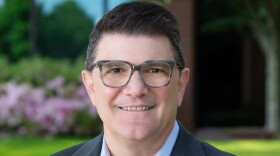Half of the offices sit empty at the chancellor's suite at UNC Greensboro. It is one sign of the downsizing that has already begun in the face of falling enrollment and a looming budget deficit.
“We're embarrassed to say how many people are actually running this university,” says Chancellor Franklin Gilliam.
Gilliam says some of the administrative positions that reported to him and the business office were among the first to go.
“It's not poor CFO, poor Chancellor. It's happening to everybody. Everybody,” he says.
The chancellor recently held an all-hands-on-deck meeting with the university’s entire Student Affairs division to consider what student service positions would need to be cut back. Nothing is an easy choice.
“Do you have fewer mental health counselors? Not a good idea today.” Gilliam says. “Do you have fewer academic advisors? Do you have fewer people in financial aid?”
After many years of steady growth, 12 of the 16 universities in the UNC System saw their student populations decline this past fall. As enrollment shrinks, so will their budgets. College enrollment has been falling nationally, but the trend has arrived in North Carolina later than in other states. Often regional public universities, like UNC Greensboro, are being hit the hardest by these enrollment trends.
UNC Greensboro is projecting a nearly $12.4 million loss in tuition, fees and state funding next school year. That will require immediate budget cuts affecting staff and services that the university has grown over the past decade.
UNC Greensboro’s undergraduate enrollment is down roughly 11% from 2020 to 2022, based on fall data. At the same time, the UNC System has changed the formula it will use to determine its request for state funding this year, shifting some priorities.
Funding pressures will pose new challenges to a university that has built a reputation for improving the economic futures of underprivileged students.
“We take kids from small towns, from inner cities, and we give them careers, and we change their lives and their families’ lives,” Gilliam says.
Almost half of UNC Greensboro undergraduate students are eligible for federal Pell grants, a common marker for students who come from low-income backgrounds. In 2022, US News & World Report ranked UNC Greensboro number 1 in North Carolina — and 18th in the country — for social mobility.
“If you want to have a prosperous state, if you want to reduce income inequality, if you want to rebuild the middle class, these are the students who are going to do it,” Gilliam says. “But they need support.”

The UNC System is adjusting to a changing landscape
What’s happening to enrollment at UNC Greensboro and other mid-size public universities is part of a changing tide in higher education. Nationally, the traditional pool of college applicants — recent high school graduates — is receding because the birth rate fell after the Great Recession. Now, since the pandemic began, even fewer of those graduates are choosing to go to college at all.
UNC System leaders have been watching and preparing for these demographic changes. In September, UNC System President Peter Hans spoke of these trends in his monthly speech to the system’s board of governors.
“American universities have benefited from a decades-long tailwind of population growth and greater demand for higher education,” Hans said. “That period is drawing to a close.”
Hans pointed to a large chart comparing the national decline in college enrollment to UNC System’s enrollment. The national line dips down long before the UNC System’s growth begins to waver.
Hans then described a list of things the UNC System is doing to prepare. His list includes:
- holding in-state tuition flat for seven years to improve affordability
- developing a new online course model to serve adult students
- allowing some universities to admit a higher portion of out-of-state students
- changing the university’s state funding formula to incentivize on-time graduation rates
UNC System officials are proud of the now seven-year freeze on in-state undergraduate tuition and the dedication it shows to keeping college costs low for North Carolinians.
“It’s the North Carolina way, and we’re determined to preserve it,” Hans said as he announced the continued freeze.
It's great news for students, but in a time of inflation, it also limits a key revenue source for universities that don't have large research grants or a lot of out-of-state students that pay more for tuition.


By allowing some universities to admit more out-of-state students, those that have been bumping up against the System's cap on those students will benefit. However, UNC Greensboro has never come very close to meeting that cap and has historically focused its recruitment on students from North Carolina.
The UNC System is also making a crucial change to how it determines state funding for universities. In the old formula, state funding was based heavily on a university’s total student enrollment. The new formula shifts the focus to in-state students seeking bachelor's degrees, and it rewards universities for graduating students on time with less debt.
In other words, the old model rewarded universities for getting any students in the door, the new model incentivizes helping in-state students in particular.
The new formula does not include state funding for out-of-state students, and it puts more weight on a study that calculates the cost to educate students in different academic areas. More state funding will go to support STEM and medical fields compared to other departments. Those changes may further shift priorities at some universities in terms of funding graduate student research or allocating funding between different departments.
The new funding formula is also having a positive effect on state funding at universities that meet performance goals set by the UNC System.
UNC Greensboro officials say the university will receive about $2.5 million in additional funding from the new model’s performance weighting, but it's still facing a budget deficit due to falling enrollment.
“When enrollment declines, there's going to be less state funding, there's nothing new about that,” Hans says in an interview. “This is not somehow a new development as a result of funding formula changes.”
UNC System CFO Jennifer Haygood says the administration is working on ways to soften the blow falling enrollment will have on budgets.
“I do think that it's appropriate for us to adjust to those changing enrollment patterns,” she says. “I think we'll continue just to focus on the pace of those adjustments.”
The UNC System Board of Governors Budget Committee voted in November to cap the losses in state funding at UNC Asheville, UNC Greensboro and UNC Pembroke at 4.5%. The UNC System is also requesting $16.8 million from the General Assembly for a retirement incentive for eligible faculty, with priority given to the five universities most affected by enrollment declines.
“I don't think that it is realistic to expect the taxpayer in North Carolina to continue to essentially pay for the same level if we're actually serving fewer students,” Haygood says.
Why is UNC Greensboro being hit so hard by enrollment trends?
In the UNC System, UNC Asheville and UNC Pembroke had the steepest declines in enrollment as a percentage of their student population this past fall, but UNC Greensboro is a much larger university and lost more students than the other two institutions combined.
After the UNC System set a cap on state funding losses at those three universities, UNC Greensboro will lose the most state funding in actual dollars. Before the cap, it also stood to lose the most as a percentage of its overall funding.
There are many reasons why UNC Greensboro and other regional public universities are bearing the brunt of a national decline in college enrollment.
UNC Greensboro has mainly recruited students from within the state, and as that traditional population wanes, it increases competition with other UNC System schools.
University officials know which schools students ultimately choose when they apply but don’t accept an offer to attend. UNC Greensboro’s largest competitors are UNC Charlotte and Appalachian State University.
This year, the third most common category of students who were accepted to UNC Greensboro but chose not to attend is what’s called a “non-consumer of higher education.”
“That was a term that I had never heard of until this year, but it's students that choose not to go to higher education,” says UNC Greensboro CFO Bob Shea. “They've been accepted to UNCG and they opt not to go anywhere.”
The number of students transferring from community colleges has also declined as enrollment fell at the state’s community colleges during the pandemic. UNC Greensboro received about a thousand fewer transfer students in fall 2022 than in fall 2019.
UNC Greensboro also loses some applicants to HBCUs, which are seeing a surge in popularity; some to NC Promise schools that offer low-cost tuition subsidized by the state; and some to more selective schools like NC State University because the UNC System has made tests like the SAT and ACT optional on college applications since the pandemic began.
The increased competition for students will create winners and losers.
“The only institutions that will see enrollment growth over the next decade, are the elites, the flagship state universities and highly endowed privates,” Gilliam says. “Then the remainder of the sector, which is 75 to 80%, is going to see decline.”
Faculty worry for their jobs and their students

Right now, the pace of change is bringing uncertainty for faculty who don’t yet know what next year holds.
Among its cost-cutting measures, UNC Greensboro has restructured contracts for non-tenured faculty, shortening many contracts to one year. The university has implemented a “soft hiring freeze” that requires any job postings to be approved by the provost and CFO, whether filling a vacancy or creating a new position.
“I don't know if my contract will be renewed at some point,” says UNG Greensboro senior lecturer Wade Maki, who teaches ethics courses to business students.
“I don't know if all of the faculty who support my program will be renewed,” Maki says. “We don't know exactly how large the class sizes are going to have to be.”
Gilliam says some departments and positions may be affected more than others, but specifics haven’t been released to faculty yet.
“Everything's on the table. Every service is in danger, and what it's in danger of is being understaffed,” Gilliam says.
Maki also chairs the UNC Faculty Assembly, which serves an advisory role to UNC System administrators.
“Early on in this year, in the faculty assembly, I would talk to the senate chairs from all the other campuses, and I would tell them what was happening at UNCG,” Maki says.
“Our chancellor uses the phrase ‘we’re the tip of the spear,’” Maki continues. “We really are because I would tell them what was happening in terms of the funding model, enrollment, and these other senate chairs said, ‘We're not hearing that.’ And then every week or so somebody’d say, ‘Hey, that's happening to us.’”
Chancellor Gilliam says what worries him the most is that the rapid cuts to faculty, staff and services will also affect students, and the university's ability to retain and graduate them.
“We do have to remember that there's a human side to all of this,” Gilliam says. “At base, we're talking about people and their livelihoods, and their ability to help students and graduate students — and that's our mission.”
University leaders across the state and country must find ways to adapt to the changing demand for higher education, Gilliam says.
“I’ve been in this business 40 years, as either a professor or an administrator, and I argue it’s the greatest challenge of higher ed in a hundred years,” Gilliam says.




















